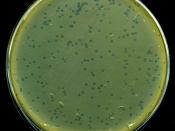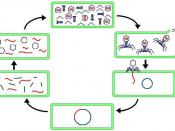PRACTICAL4
Introduction
The purpose of this experiment is to demonstrate viral specificity. In this practical viral specificity is used as a tool to determine the unknown bacteria. Known bacteriophages can be used to determine unknown bacteriophages by observing whether the bacteria are lysed or not.
DISCUSSION
There strains that will be affected by the bacteriophages and there are those that will not be affected. Those that lack the viral receptor will show no reduction of the growth in the circled zone. The amount of reduction of growth in sensitive strains will depend on the viral specificity of the bacteriophage particles in the phage streak and on whether the virus is virulent or temperate. Virulent phages will show little or a larger zone of inhibition where the phage drops has been inoculated.
Many bacteriophages are temperate and can establish a latent infection of their host termed lysogeny. In this state, the viral genome is known as a prophage, and the host is said to be lysogenized or a lysogen.
Summary of procedure
Two phages of E .coli are inoculated in two separate test tubes containing sterile PBS, and the test tube are named one and two respectively. Then four plates inoculated with four different unknown bacteria are named 1-4 respectively. Then each plate is divided into two halves using a marking pen. On each half, a circle is drawn and where the circle is drawn, a drop of PBS phage solution is placed. A circle where a drop is placed is where a possible zone of inhibition will occur depending on the effectiveness of the phage solution.
Results obtained
Bacteria Test tube 1 Test tube 2
1 No clear zone No clear zone
2 No clear zone No clear zone
3 Clear zone No clear zone
4 No clear zone No...


